Zoom
Trash

steven
Documents_TER. Sdn.sap. Social Media Monitoring, Analytics and Alerts Dashboard. Create a Free Website, Online Store, or Blog. jQuery UI Demos. jQuery UI offers a combination of interaction, effects, widgets, utilities, and themes designed to work well together or on their own.
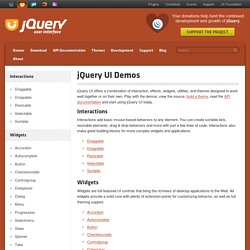
Play with the demos, view the source, build a theme, read the API documentation and start using jQuery UI today. Interactions Interactions add basic mouse-based behaviors to any element. You can create sortable lists, resizable elements, drag & drop behaviors and more with just a few lines of code. Interactions also make great building blocks for more complex widgets and applications. Widgets Widgets are full-featured UI controls that bring the richness of desktop applications to the Web. Effects Effects add support for animating colors and class transitions, as well as providing several additional easings. Utilities Utilities used by jQuery UI to build interactions and widgets. Ajax() Description: Perform an asynchronous HTTP (Ajax) request.

The $.ajax() function underlies all Ajax requests sent by jQuery. It is often unnecessary to directly call this function, as several higher-level alternatives like $.get() and .load() are available and are easier to use. If less common options are required, though, $.ajax() can be used more flexibly. At its simplest, the $.ajax() function can be called with no arguments: Note: Default settings can be set globally by using the $.ajaxSetup() function. jQuery- Parse JSON, XML and HTML.
In this post, find out jQuery code on how to parse JSON, parse XML and parse HTML.

If you are still using custom code for parsing any of these and making your life more miserable then stop doing it. Why? If you are not aware then here is a news for you that jQuery has inbuilt utility methods for each. jQuery AJAX Methods. UI Layout Plug-in - Home. jQuery et les événements. En jQuery, et même plus globalement en JavaScript, on peut faire appel aux gestionnaires d'évènements.
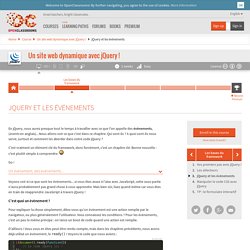
Ce sont des fonctions auxquelles on donne un type d'évènement à écouter, ainsi qu'une fonction à exécuter à chaque fois que l'évènement est déclenché. Elles sont plusieurs et nous allons les étudier car elles représentent une partie importante de ce chapitre, si ce n'est LA plus importante ! Rappels Si vous lisez ce cours, c'est que vous avez quand même quelques notions en JavaScript. Dans un premier temps, rappelez-vous la méthode que vous utilisiez pour écouter un évènement. Un troisième paramètre pouvait être défini à true ou false, et permettait d'utiliser soit la phase de capture, soit la phase de bouillonnement. L'écoute en jQuery Sachez qu'avec notre framework, il est possible de réaliser la même chose.
Quelle différence entre ces deux fonctions ? Précédemment, vous avez vu comment déclencher un évènement simple. $('button').on('click', function(){ alert('Ce code fonctionne ! ') jQuery : l’événement ! Enfin « les », événements.
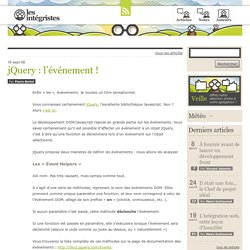
Je voulais un titre sensationnel. Vous connaissez certainement jQuery, l’excellente bibliothèque Javascript. Cookies With jQuery - Designing Collapsible Layouts » ShopDev Website Design Blog. The ability to set and read cookies is a very useful feature of many programming languages.
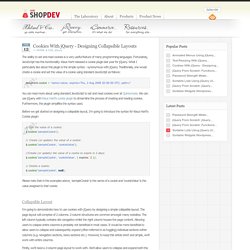
Fortunately, JavaScript has this functionality. Klaus Hartl released a cookie plugin last year for jQuery. What I particularly like about this plugin is the simple syntax - synonymous with jQuery. Traditionally, one would create a cookie and set the value of a cookie using standard JavaScript as follows: document.cookie = 'name=value; expires=Thu, 2 Aug 2008 20:00:00 UTC; path=/' You can read more about using standard JavaScript to set and read cookies over at Quirksmode. Before we get started on designing a collapsible layout, I’m going to introduce the syntax for Klaus Hartl’s Cookie plugin: Please note that in the examples above, ’sampleCookie’ is the name of a cookie and ‘cookieValue’ is the value assigned to that cookie. SaaS, PaaS, IaaS : Cloud computing, mais quelles différences ? - e-liance e-liance.
8 oct 2013.

Multi-Tenancy Design Consideration. Introduction.
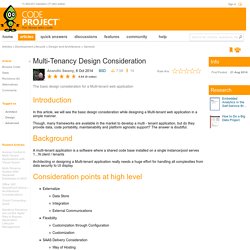
Architecting a Multi-tenant Application. A multi-tenant application is an application where a single running instance serves many customers.

An alternative to multi-tenancy is managed services, where one running instance is set up for each customer. The table below shows a comparison between the two approaches. For SaaS products it can be seen that there are a number of benefits if the product is a multi-tenant product. But for an application to benefit by multi-tenancy, it’s architecture should take care of: Data IsolationFeature CustomizationExecution Environment Isolation. Cloud – “Multi-tenancy” vs “Single-tenancy” Mise en route. Configuration XML ECLIPSE. Task 2: Enable Single-Table Multi-Tenancy Single-table multi-tenancy can be enabled declaratively using the @Multitenant annotation, in an Object Relational Mapping (ORM) XML file using the <multitenant> element, or by using annotations and XML together.

Using the @Multitenant Annotation To use the @Multitenant annotation, include it with an @Entity or @MappedSuperclass annotation. For example: @Entity @Table(name=“EMP”) @Multitenant(SINGLE_TABLE) public class Employee { } The open source framework for building multi tenant SaaS platforms, products and enterprise applications in PHP. Athena Framework for Java Multitenancy Tutorial - Athena Framework. Multi-tenancy in Java. Multi-Tenant SaaS Applications with Stormpath - Stormpath. In this guide, we discuss what a multi-tenant SaaS application is and how to model user data for SaaS apps serving many organizations. We will also show how to build a multi-tenant SaaS application faster and more securely with Stormpath, a cloud-hosted user management service, that easily supports multi-tenant user models.
What is Stormpath? Stormpath is a user management API that makes it easy for developers to launch applications with secure, scalable user infrastructure. It automates: User Account registration and loginAuthentication and authorizationFlexible, secure user profile dataGroup and role management, including pre-built Role-Based Access Control (RBAC)Best-practice password security and data storageIntegration with on-premise LDAP and Active Directory servers You access Stormpath via a beautiful REST+JSON API or our language-specific SDKs. Chapter 16. Multi-tenancy. Enterprise Social Networking Software. Logiciel CRM / GRC , Gestion de la Relation Client. Employee Engagement Software - Communifire. SAP%20HANA%20SPS%2009%20-%20Multitenant%20Database%20Cont.pdf. Solutions.